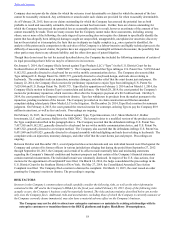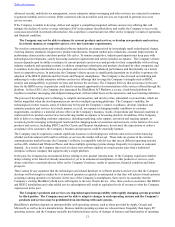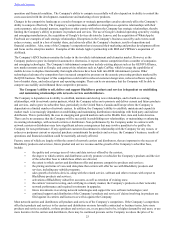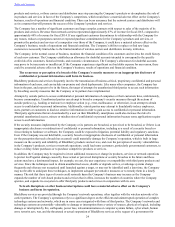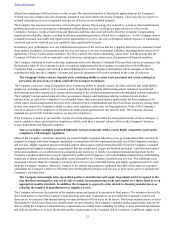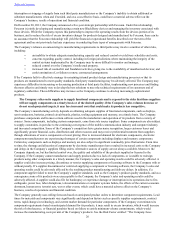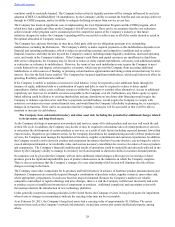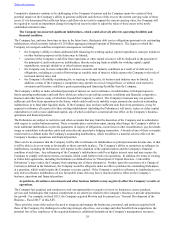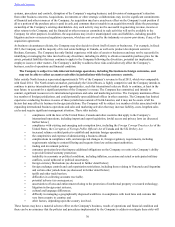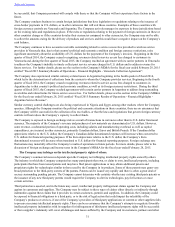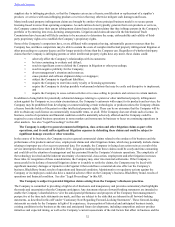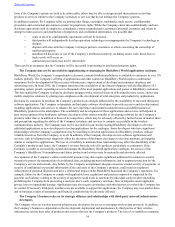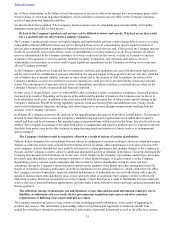Blackberry 2015 Annual Report Download - page 35
Download and view the complete annual report
Please find page 35 of the 2015 Blackberry annual report below. You can navigate through the pages in the report by either clicking on the pages listed below, or by using the keyword search tool below to find specific information within the annual report.
Table of Contents
26
interruption or stoppage of supply from such third party manufacturers or the Company’s inability to obtain additional or
substitute manufacturers when and if needed, and on a cost-effective basis, could have a material adverse effect on the
Company’s business, results of operations and financial condition.
On December 20, 2013, the Company announced a five-year strategic partnership with Foxconn. Under this relationship,
Foxconn is jointly developing and manufacturing certain new BlackBerry devices and managing the inventory associated with
those devices. While the Company expects this partnership to improve the operating results from the devices portion of its
business, and to reduce the risk of excess inventory charges for products designed and manufactured by Foxconn, there can be
no assurance that the Foxconn relationship will yield the financial or operational benefits described over the term of the
agreement and has not previously had any experience in conducting these types of arrangements with Foxconn.
The Company’s reliance on outsourcing its manufacturing requirements to third parties may involve a number of other risks,
including:
• an inability to obtain adequate manufacturing capacity and reduced control over delivery schedules and costs;
• concerns regarding quality control, including in foreign jurisdictions where maintaining the integrity of the
control systems implemented by the Company may be more difficult to monitor and manage;
• reduced control over the Company’s intellectual property;
• increased risk of counterfeit and fraudulent activities giving rise to the availability of unauthorized devices; and
• early termination of, or failure to renew, contractual arrangements.
If the Company fails to effectively manage its remaining internal product design and manufacturing processes so that its
products are manufactured to meet quality standards, third party manufacturing may be adversely affected. The Company may
experience difficulties in increasing or decreasing production at third party facilities, implementing new processes and finding
the most effective and timely way to develop the best solutions to meet the technical requirements of its customers and of
regulatory authorities. These difficulties may increase as the Company continues to develop increasingly sophisticated
products.
The Company relies on its suppliers to supply functional components and is exposed to the risks that these suppliers
will not supply components on a timely basis or of the desired quality; if the Company’s sales volumes decrease or
do not reach projected targets, it may face increased costs that could make its products less competitive.
The Company’s manufacturing activity depends on obtaining adequate supplies of functional components, such as displays,
semi-conductors, batteries, printed circuit boards, plastics, tooling equipment and memory, on a timely basis. The Company
purchases components and licenses certain software used in the manufacture and operation of its products from a variety of
sources. Some components, including custom components, come from sole source suppliers. Some components are also subject
to supply constraints, in part due to the continuing convergence of the mobile communication industry and computer industry,
and increased competition. Some of the Company’s competitors have greater name recognition, larger customer bases and
significantly greater financial, sales, distribution and other resources and may receive preferential treatment from suppliers
through allocations of scarce components or lower pricing. Due to increased demand for electronic components, electronic
component manufacturers are experiencing shortages of certain components including displays and memory components.
Certain key components such as displays and memory are also subject to significant commodity price fluctuations. From time
to time, the shortage and allocation of components by electronic manufacturers have resulted in increased costs to the Company
and delays in the Company’s suppliers filling orders. Alternative sources of supply are not always available. Moreover, the
Company depends on, but has limited control over, the quality and reliability of the products supplied or licensed to the
Company. If the Company cannot manufacture and supply products due to a lack of components, or is unable to redesign
products using other components in a timely manner, the Company’s sales and operating results could be adversely affected. A
supplier could also increase pricing, discontinue or restrict supplying components or licensing software to the Company with or
without penalty. If a supplier discontinued or restricted supplying a component or licensing software, the Company’s sales and
operating results could be adversely affected by the resulting product manufacturing and delivery delays. In addition, if a
component supplier failed to meet the Company’s supplier standards, such as the Company’s product quality standards, and as a
consequence some of its products were unacceptable to the Company, the Company’s sales and operating results could be
adversely affected. A supplier could also file for bankruptcy or experience damage or interruption in its operations due to fire,
earthquake, power loss, labor disruptions, telecommunications or computer systems failure, the effects of the current economic
downturn, human error, terrorist acts, war or other events, which could have a material adverse effect on the Company’s
business, results of operations and financial condition.
The Company generally uses rolling forecasts based on anticipated product orders to determine component requirements. Lead
times for materials and components vary significantly and depend on factors such as specific supplier requirements, contract
terms, rapid changes in technology, and current market demand for particular components. If the Company overestimates its
component requirements based on anticipated demand for its products, it may result in excess inventory, which would increase
the risk of obsolescence, or financial penalties based on failure to satisfy minimum volume commitments, which would
increase the manufacturing costs per unit of the Company’s products. See the Risk Factor entitled: “The Company faces




